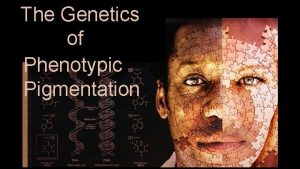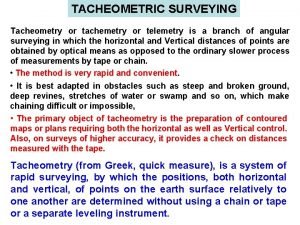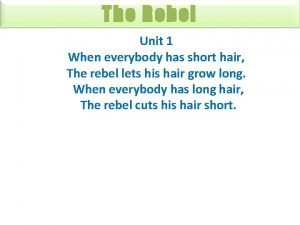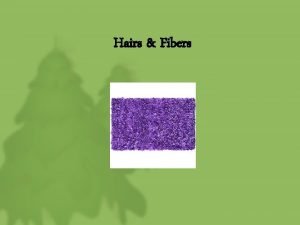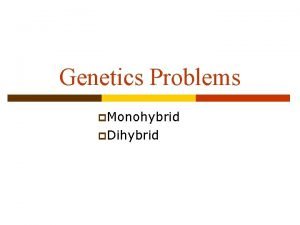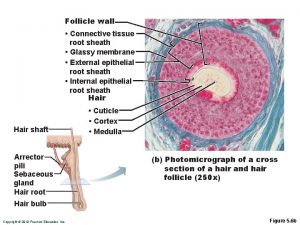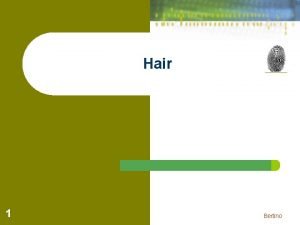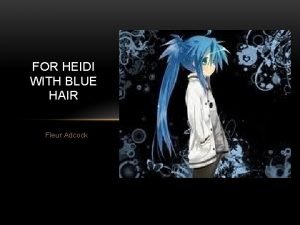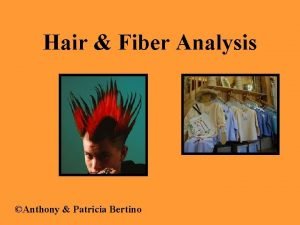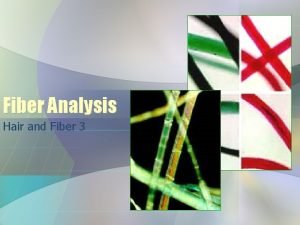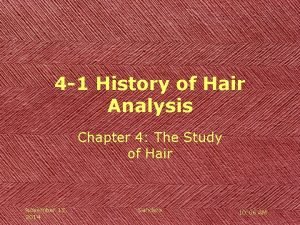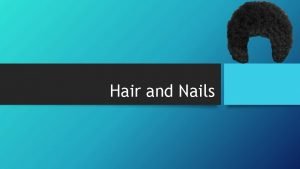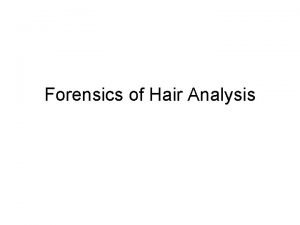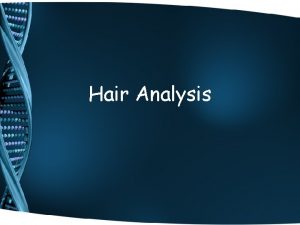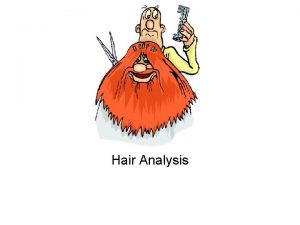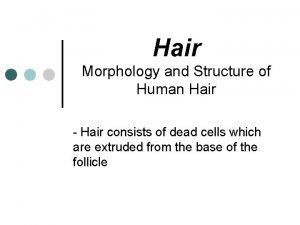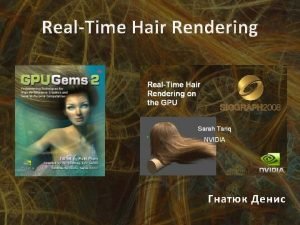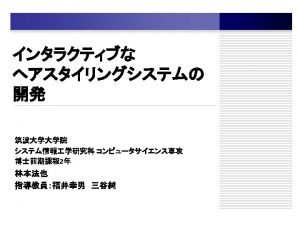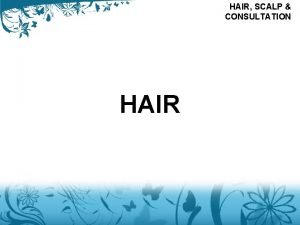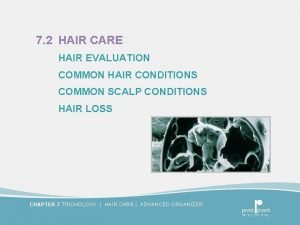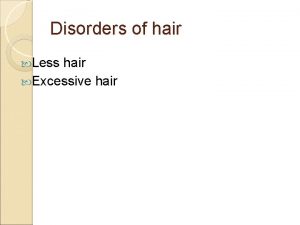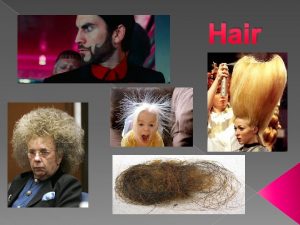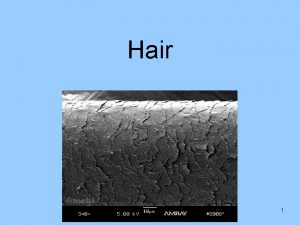Hair Hair Analysis Students will learn hair is























- Slides: 23

Hair

Hair Analysis Students will learn: § hair is class evidence § hair can be used to back up circumstantial evidence § hair absorbs substances both from within the body and from the external environment 1

Hair Analysis Students will be able to: § Describe the structure of a hair § Explain the difference between human and animal hair § Explain which characteristics of hair are important forensic analysis § Assess the probative value of hair samples 2

Introduction § Human hair is one of the most frequently found pieces of evidence at the scene of a violent crime. It can provide a link between the criminal and the crime. § From hair one can determine: § § § If the source is human or animal Race (sometimes) Origin of the location on the source’s body Whether the hair was forcibly removed If the hair has been treated with chemicals If drugs have been ingested 3

Skin Structure 4

Hair Shaft Composed of: § Cuticle—outside covering, made of overlapping scales § Cortex—inner layer made of keratin and imbedded with pigment; also contains air sacs called cortical fusi § Medulla—inside layer running down the center of the cortex 5

The Cuticle The cuticle is the outermost layer of hair which is covered with scales. The scales point toward the tip of the hair. Scales differ between species of animals and ________________ are named based on their appearance. The three basic patterns are: § Coronal § Spinous § Imbricate 6

Human Scales In order to visualize the Scales: § paint clear fingernail polish on a glass slide § when the polish begins to dry, place a hair on the polish § when almost dry, lift off the hair and observe the scale imprints What pattern is seen in this slide? 7

The Cortex The cortex gives the hair its shape. It has two major characteristics: § Melanin—pigment granules that give hair its color § Cortical fusi—air spaces, usually found near the root but may be found throughout the hair shaft 8

The Medulla The medulla is the hair core that is not always visible. The medulla comes in different types and patterns. Types: § Intermittent or interrupted § § Fragmented Continuous Stacked Absent—not present 9

Human Medulla Human medulla may be continuous, fragmented or absent. 10

Medullary Index Determined by measuring the diameter of the medulla and dividing it by the diameter of the hair. mouse § Medullary Index for human hair is generally less than 1/3. § For animal hair, it is usually greater than 1/2. 11

Hair Shape Can be straight, curly or kinky depending on the cross-section, which may be round, oval or crescent-shaped Round (Straight) Oval (Curly) Crescent moon (Kinky) 12

Hair Growth § § Terminology § Anagen—hair that is actively growing; lasting up to 5 years § § Catagen—hair is not growing; a resting phase Telogen—hair that is dying and ready to fall out; lasting two to six months Length—about 0. 5 mm per day or 1 centimeter per month; approximately one half inch per month 13

The Root Human roots look different based on whether they have been forcibly removed or if they are telogen hairs and have fallen out. Animal roots will vary, but in general have a spear shape. Fallen out Forcibly removed 14

Hair Comparison § § Color Length Diameter Distribution, shape and color intensity of pigment granules § Dyed hair has color in cuticle and cortex § Bleaching removes pigment and gives a yellow tint § Scale types § Presence or absence of medulla § Medullary type § Medullary pattern § Medullary index 15

DNA from Hair § The root contains nuclear DNA. If the hair has been forcibly removed, some folicular tissue may be attached containing DNA. § The hair shaft contains abundant mitochondrial DNA, inherited only from the mother. It can be typed by comparing relatives if no DNA from the body is available. This process is more difficult and costly than using nuclear DNA. 16

Collection of Hair § Questioned hairs must be accompanied by an adequate number of control samples. § from victim § from possible suspects § from others who may have deposited hair at the scene § Control Sample § 50 full-length hairs from all areas of scalp § 24 full-length pubic hairs 17

Hair Toxicology § Advantages: § Easy to collect and store § Is externally available § Can provide information on the individual’s history of drug use or of poisoning. § Collections must be taken from different locations on the body to get an accurate timeline. 18

Hair Toxicology § Napoleon died in exile in 1821. By analyzing his hair, some investigators suggest he was poisoned by the deliberate administration of arsenic; others suggest that it was vapors from the dyes in the wallpaper that did him in. 19

More about Hair For additional information about hair and other trace evidence, check out Court TV’s Crime Library at: www. crimelibrary. com/criminal_mind/forensics/trace/1. html 20

Lab Reports: Always typed ‡ Cover Page ‡ ‡ ‡ Your names Group number Lab title Date Question Investigating (aka purpose) ‡ Materials and Procedure ‡ Brief. Only need new material not used before ‡ For procedure 3 -5 sentence paragraph 21

Lab Report continued ‡ Data Table ‡ Organized ‡ Analysis ‡ Calculations ‡ Graphs ‡ Conclusion ‡ Make a claim ‡ Support the claim 22
 Tactile learner definition
Tactile learner definition Motivating students to learn english
Motivating students to learn english Why was/were rizal called the champion of filipino students
Why was/were rizal called the champion of filipino students Swot analysis for english teachers
Swot analysis for english teachers Site:slidetodoc.com
Site:slidetodoc.com Dark hair and blonde hair parents
Dark hair and blonde hair parents Tacheometric surveying formula
Tacheometric surveying formula What does a rebel do when everybody wears a uniform
What does a rebel do when everybody wears a uniform Hair grows in diagonal tubes called hair
Hair grows in diagonal tubes called hair The most prevalent plant fiber is
The most prevalent plant fiber is Heterozygous tabby x stripeless
Heterozygous tabby x stripeless Hair follicle glassy membrane
Hair follicle glassy membrane The two primary parts of hair are the hair fiber and the:
The two primary parts of hair are the hair fiber and the: History of hair analysis
History of hair analysis For heidi with blue hair poem pdf
For heidi with blue hair poem pdf Hair type
Hair type 6 elements of hair design
6 elements of hair design Morphology of hair forensic science
Morphology of hair forensic science The cutting of my long hair analysis
The cutting of my long hair analysis Fleur adcock for heidi with blue hair
Fleur adcock for heidi with blue hair The most common type of plant fiber is
The most common type of plant fiber is The poem my parents
The poem my parents Bernice bobs her hair analysis
Bernice bobs her hair analysis History of hair analysis
History of hair analysis





